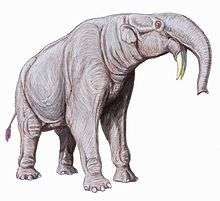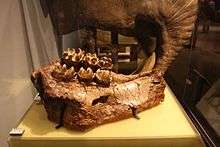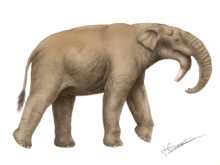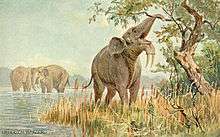Deinotherium
Deinotherium ("terrible beast" derived from the Ancient Greek δεινός, deinos meaning "terrible" and θηρίον, therion meaning "beast") was a large prehistoric relative of modern-day elephants that appeared in the Middle Miocene and survived until the Early Pleistocene. During that time, it changed very little. In life, it probably resembled modern elephants, except it had downward-curving tusks attached to the lower jaw.
| Deinotherium | |
|---|---|
| D. giganteum skull from Oxford University Museum of Natural History | |
| Scientific classification | |
| Kingdom: | Animalia |
| Phylum: | Chordata |
| Class: | Mammalia |
| Order: | Proboscidea |
| Family: | †Deinotheriidae |
| Subfamily: | †Deinotheriinae |
| Genus: | †Deinotherium Kaup, 1829 |
| Species | |
|
D. bozasi (Arambourg, 1934) | |
| Synonyms | |
Dinotherium
Deinotherium gigantissimum | |
Taxonomy and evolution

Deinotherium is the type genus of the family Deinotheriidae, which evolved from the smaller, early Miocene Prodeinotherium. These proboscideans represent a totally distinct line of evolutionary descent to that of other elephants, one that probably diverged very early in the history of the group as a whole. The large group to which elephants belong formerly contained several other related groups; besides the deinotheres, there were the gomphotheres (some of which had shovel-like lower front teeth), and the mastodons. Only the elephants survive today.
Three species are recognized, all of great size. Deinotherium giganteum is the type species, and is described above. It was primarily a Late Miocene species, most common in Europe, and is the only species known from the circum-Mediterranean. Its last reported occurrence was from the Middle Pliocene of Romania (2 to 4 million BP). An entire skull, found in the Lower Pliocene beds of Eppelsheim, Hesse-Darmstadt in 1836, was 1.2 m (3 ft 11 in) long and 0.9 m (2 ft 11 in) wide, indicating an animal exceeding modern elephants in size. D. indicum was the Asian species, known from India and Pakistan. It is distinguished by a more robust dentition and p4-m3 intravalley tubercles. D. indicum appeared in the Middle Miocene, and was most common in the Late Miocene. It disappeared from the fossil record about 7 million years BP (Late Miocene). D. bozasi was the African species. It is characterized by a narrower rostral trough, a smaller but higher nasal aperture, a higher and narrower cranium, and a shorter mandibular symphysis than the other two species. D. bozasi appeared at the beginning of the Late Miocene, and continued there after the other two species had died out elsewhere. The youngest fossils are from the Kanjera Formation, Kenya, about 1 million years old (Early Pleistocene).
Description



Deinotherium was a large proboscidean. Two adults of D. giganteum are around 3.6–4.0 m (11.8–13.1 ft) tall and weighed 8.8–12 tonnes (8.7–11.8 long tons; 9.7–13.2 short tons). This is similar to adult males of D. proavum, one of which weighed 10.3 tonnes (10.1 long tons; 11.4 short tons) and was 3.59 m (11.8 ft) tall. However, both these species are smaller than a 45-year-old male of D. "thraceiensis", at 4.01 m (13.2 ft) tall and 13.2 tonnes (13.0 long tons; 14.6 short tons).[1]
The permanent tooth formula of D. giganteus was 0-0-2-3/1-0-2-3 (deciduous 0-0-3/1-0-3), with vertical cheek tooth replacement. Two sets of bilophodont and trilophodont teeth were present. The molars and rear premolars were vertical shearing teeth, and show that deinotheres became an independent evolutionary branch very early on; the other premolars were used for crushing. The cranium was short, low, and flattened on the top, in contrast to more advanced proboscideans, which have a higher and more domed forehead, with very large, elevated occipital condyles. The nasal opening was retracted and large, indicating a large trunk. The rostrum was long and the rostral fossa broad. The mandibular symphyses (the lower jaw-bone) were very long and curved downward, which, with the backward-curved tusks, is a distinguishing feature of the group; it possessed no upper tusks.
Deinotherium is distinguished from its predecessor Prodeinotherium by its much greater size, greater crown dimensions, and reduced development of posterior cingula ornamentation in the second and third molars.[2]
Paleoecology

The way Deinotherium used its curious tusks has been much debated. It may have rooted in soil for underground plant parts like roots and tubers, pulled down branches to snap them and reach leaves, or stripped soft bark from tree trunks. Deinotherium fossils have been uncovered at several of the African sites where remains of prehistoric hominid relatives of modern humans have also been found. Early Pleistocene species of young Deinotherium might have also fallen prey to Homotherium.[3]
Distribution
Deinotherium's range covered parts of Asia, Africa, and Europe. Adrienne Mayor, in The First Fossil Hunters: Paleontology In Greek and Roman Times, has suggested that deinothere fossils found in Greece helped generate myths of archaic giant beings. A tooth of a deinothere found on the island of Crete, in shallow marine sediments of the Miocene[4] suggests that Crete was closer or connected to the mainland during the Messinian salinity crisis.
References
- Larramendi, A. (2016). "Shoulder height, body mass and shape of proboscideans" (PDF). Acta Palaeontologica Polonica. 61. doi:10.4202/app.00136.2014.
- Sanders, W. J., 2003, chap 10, Proboscidea, in Mikael Fortelius (ed) Geology and paleontology of the Miocene Sinap Formation, Turkey, Columbia University Press, New York
- https://chasingsabretooths.wordpress.com/2017/03/23/deinotheres-for-lunch-a-sabertooths-tough-skinned-diet/
- Athanassiou, A. 2004. On a Deinotherium (Proboscidea) finding in the Neogene of Crete. Carnets de Géologie/Notebooks on Geology.
Further reading
- Carroll, R.L. (1988), Vertebrate Paleontology and Evolution, WH Freeman & Co.
- Colbert, E. H. (1969), Evolution of the Vertebrates, John Wiley & Sons Inc (2nd ed.)
- Harris, J.M. (1976) Evolution of feeding mechanisms in the family Deinotheriidae (Mammalia: Proboscidea). Zool. J. Linn. Soc. 56: 331-362
- Athanassios Athanassiou, On a Deinotherium (Proboscidea) finding in the Neogene of Crete: abstract
- Chisholm, Hugh, ed. (1911). . Encyclopædia Britannica (11th ed.). Cambridge University Press.
External links
| Wikimedia Commons has media related to Deinotherium. |
| Wikispecies has information related to Deinotherium |
- Deinotherium Factfile - ABC
- . New International Encyclopedia. 1905.